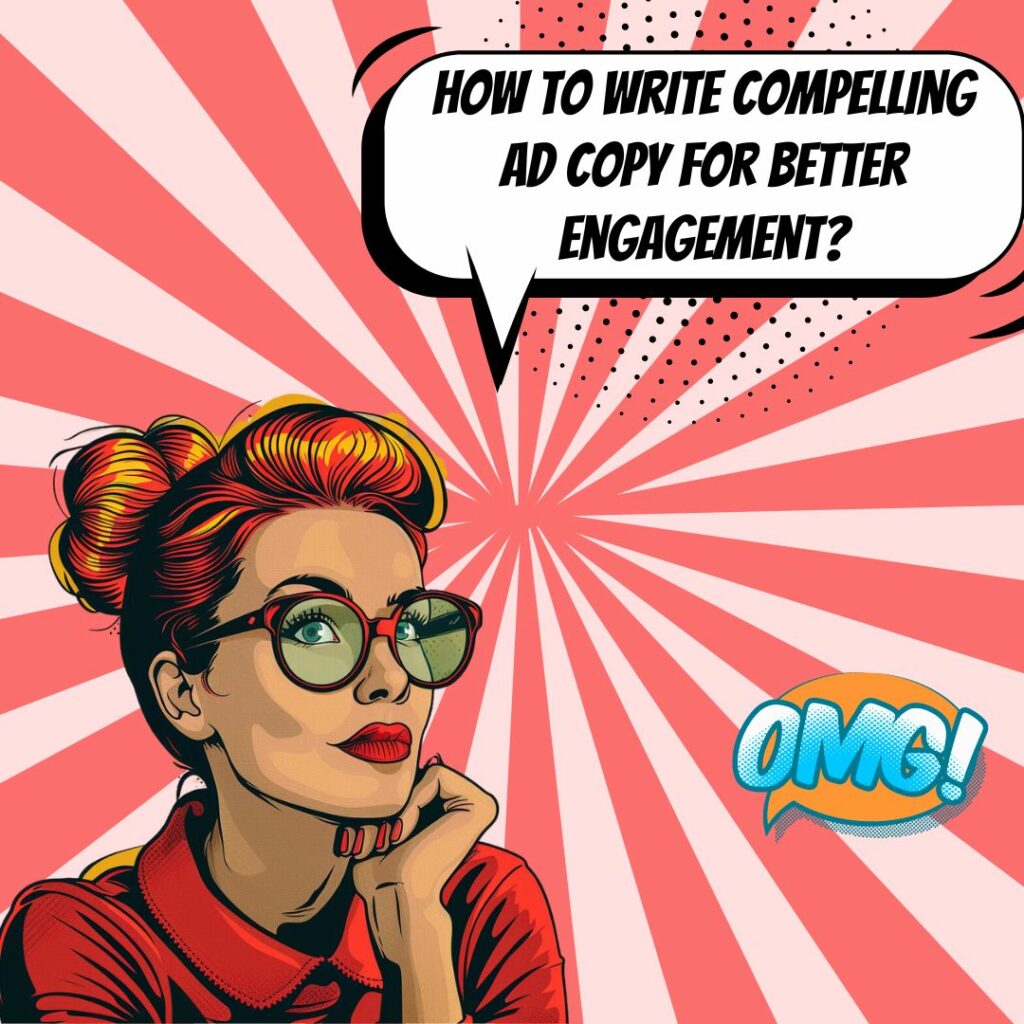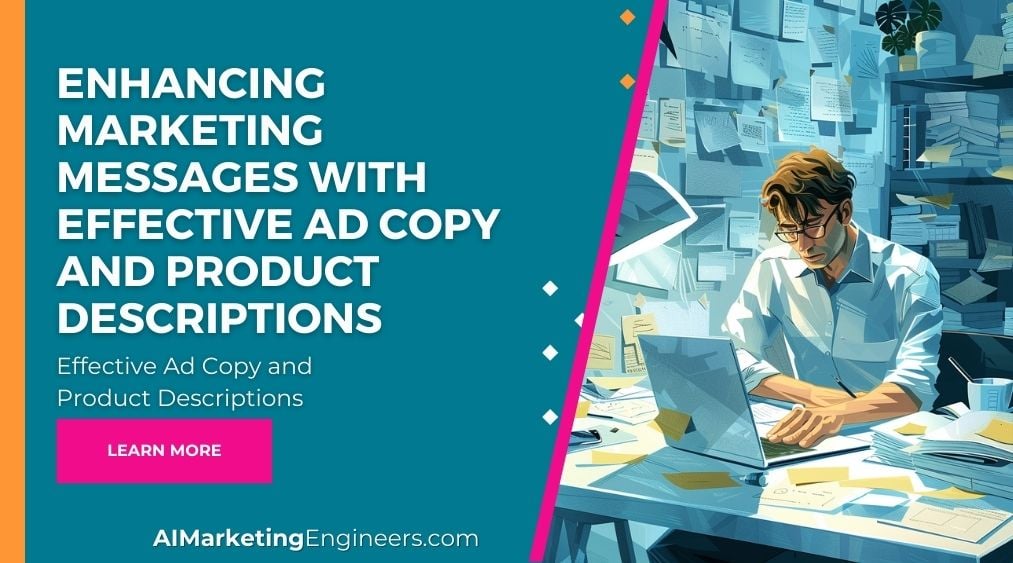Key Takeaways
✅ Clear and Concise Messaging: In a world overflowing with information, your ad copy and product descriptions need to cut through the noise. Statistics show that concise messages have a 38% better chance of grabbing attention. Keep it simple, direct, and make sure the core message about your product or service shines through.
✅ Emphasis on Benefits Over Features: Why should someone care about your product? It's all about the outcomes. Studies reveal that messages highlighting benefits over features can increase interest in a product by up to 70%. Remember, it's not what your product can do; it's how it makes life better for your customers.
✅ Tailoring to Your Target Audience: Did you know that personalized marketing messages can boost sales by an average of 19%? It's essential to understand and speak directly to the needs and desires of your audience. Dive into research and data analysis to wrap your messages around your customer's world.

Introduction
Ever wondered why some marketing messages stick in your mind and others don't? It's not just about what you're selling; it's about how you tell the story. Today, with the average person bombarded by thousands of marketing messages daily, ad copy and product descriptions play a pivotal role in determining whether your message flourishes or fades away.
Imagine unlocking secrets that propel your prose from mundane to mesmerizing. This article isn't just another run-of-the-mill marketing guide. It's your treasure map to crafting irresistible marketing content. Here, we'll share insights that could skyrocket your revenue, make your Return On Ad Spend (ROAS) figures jump off the charts, and fine-tune your Return On Investment (ROI) in ways you've never seen before. As you continue reading, gear up to uncover actionable insights and groundbreaking information that will change the way you communicate with your audience forever.
Top Statistics
| Statistic | Insight |
|---|---|
| Emotional Ad Language: A 76% conversion rate uplift. (Source: Unbounce, 2019) | The use of emotional language in ad copy taps into the consumer's feelings, driving significantly higher engagement and action. |
| Personalized Ad Copy: Boosts click-through rates by 202%. (Source: Instapage, 2020) | Customization in advertising is not just a buzzword; it's a proven strategy to cut through the noise and capture attention. |
| Consumer Online Research: 81% before making a purchase. (Source: Think with Google, 2021) | The vast majority of consumers now thoroughly vet products online before buying, highlighting the importance of informative and persuasive product descriptions. |
| Content versus Traditional Ads: 70% prefer product content. (Source: Demand Gen Report, 2019) | Consumers favor learning about products from content over ads, underscoring the value of high-quality product descriptions. |
| Quality Over Format: 65% of marketers agree. (Source: HubSpot, 2020) | The substance of your marketing content carries more weight than flashy design—quality is king. |
Understanding Your Target Audience
When it comes to marketing, knowing who you are speaking to is just as important as what you're saying. Have you ever wondered why certain ads seem to read your mind? It’s because those brands invest time into market research and building detailed buyer personas. If you don't understand your audience's needs, desires, and pain points, your messages might as well be whispered in a roaring stadium. Are you listening to social media chatter? Are you reading customer reviews? Using this feedback can shape a more personal and direct conversation with your potential customers through better ad copy and product descriptions.
Crafting Compelling Ad Copy
Creating compelling ad copy is an art that demands you to grab your reader's attention in a split second. Are your headlines more like a soft tap on the shoulder or a compelling nudge? Remember, effective ad copy doesn't shout; it speaks directly and vividly to the reader’s interests. It's about striking a balance between being informative and persuasive, without tipping into the realm of exaggeration. A strong call-to-action (CTA) acts as the ribbon on the present—it should encourage readers to take a specific, immediate action. Have you considered using scarcity ("limited time offer") or exclusivity ("exclusive access") in your CTA to boost its impact?
Writing Engaging Product Descriptions
Product descriptions can be the bridge between browsing and buying. These short paragraphs carry the weight of conveying your product's value and convincing prospects to take the leap. But are you being clear and concise? Too much information and your customer is overwhelmed; too little, and they're left scratching their head. The key is to highlight unique product features and benefits with a sprinkle of SEO keywords to help consumers find you in the vast ocean of the internet. The perfect product description tells a story, a narrative that places your product seamlessly into the customer’s life.
Incorporating Emotional Appeals
Let's talk about emotions; they're not just for family and friends, are they? Emotions are powerful drivers in decision-making, especially in purchasing behavior. By integrating emotional appeals into ad copy and product descriptions, brands can create a deeper connection with their audience. Have you addressed how your product can make life easier, more enjoyable, or less stressful? Whether it's the joy of experiencing something new or the relief of solving a problem, tapping into what your audience feels can be a game-changer for your marketing message.
Optimizing for Search Engines
In today’s digital age, your ad copy and product descriptions need to be found before they can be read. Are you weaving the right SEO keywords into your content without making it sound robotic? The fine art of SEO is about understanding what your potential customers are searching for and integrating those terms naturally into your copy. High-quality, keyword-rich marketing content not only helps in ranking your pages higher on search engine results pages (SERPs) but also improves the chances of engagement and conversion. Have you analyzed which terms are bringing traffic and which ones are just sitting there like undisturbed cobwebs?
AI Marketing Engineers Recommendation
Recommendation 1: Utilize Emotional Triggers in Your Ad Copy and Product Descriptions: Craft your Ad Copy and Product Descriptions to connect with your audience on an emotional level. Data shows that emotion-driven content tends to perform better in converting readers into customers. For example, a study by the Institute of Practitioners in Advertising found that ads with purely emotional content performed about twice as well as those with only rational content (31% vs. 16%). Use storytelling techniques to evoke emotions like happiness, excitement, or trust, which can motivate consumers to take action.
Recommendation 2: Integrate Social Proof and User-Generated Content: Consumers trust other consumers. According to a survey by BrightLocal, 79% of consumers trust online reviews as much as personal recommendations. Enhance your Marketing Messages by incorporating testimonials, reviews, user-generated photos, and real-life success stories into your product descriptions. This tactic not only builds credibility but also creates a sense of community around your brand, making your products more relatable and desirable.
Recommendation 3: Leverage AI-Powered Copywriting Tools for Personalization: Personalize your messaging at scale. Use AI-driven tools like Persado or Copy.ai to tailor your Ad Copy and Product Descriptions based on consumer data and engagement. These tools can analyze thousands of data points to predict which language will resonate best with your audience, leading to higher engagement rates and increased conversion. According to a report by Epsilon, 80% of consumers are more likely to make a purchase from a brand that provides personalized experiences. By personalizing your content, you're not only improving consumer experience but also enhancing the effectiveness of your marketing efforts.
Relevant Links
- Revolutionize Your Digital Marketing Strategy with Advanced AI
- Top Strategies for 2024: Boost Your Business Growth
- Enhance Your E-Commerce Strategy with AI
- Maximize Your Marketing ROI with AI Analytics
- Will AI Take Over Digital Marketing by 2024?
Conclusion
In the bustling marketplace where getting your message across can be like shouting in a storm, it's crystal clear that ad copy and product descriptions have more than just a role to play—they're the megaphone that carries your voice. They're the magic beans that, when sown with thought and care, can grow into the stalk that lifts your marketing messages high above the noise.
We've journeyed together through the intricacies of understanding your audience—realizing that knowing what makes them tick is half the battle won. Tips and tricks like creating buyer personas aren't just trendy buzzwords; they are the compass that guides you to the treasured shores of customer connection. But what's a captain without a ship? Your conducting baton—the compelling ad copy and engaging product descriptions—when wielded with precision, can orchestrate a symphony that resonates with the hearts and minds of your potential buyers.
The question now is, are you using these tools to their full potential? Are you evoking the emotions that can turn a prospect into a loyal customer? Remember, every word you write is an opportunity to bond, to reassure, to compel. And have you considered the digital landscape, optimizing these crucial components for the search engines that act as gatekeepers to visibility?
As the marketing saga continues, with every product description you finesse and every ad copy you fine-tune, remember that your message is not just a shout into the void—it's the seed of a conversation, the beginning of a relationship with each reader. So, keep refining, keep learning, and take the steps necessary to ensure that your marketing messages aren't just heard, but felt and remembered.
FAQs
Question 1: What is the role of ad copy and product descriptions in strengthening marketing messages?
Answer: Ad copy and product descriptions are your wingmen in the marketing world. They sing the praises of your products, make sure the crowd knows why they're awesome, and nudge people in the right direction – hopefully straight to that 'buy' button.
Question 2: How can I create compelling ad copy and product descriptions?
Answer: It's like making a good meal – start with the freshest insights into your audience, mix in the benefits and special bits about what you're selling, add a pinch of emotion and a sprinkle of proof from happy customers, and always, always keep it seasoned with keywords for the search engine diet.
Question 3: What are some best practices for writing effective ad copy and product descriptions?
Answer: Think of them like your everyday essentials – keep them simple, lively, and useful. Stick to the point, chat like you're talking to a friend, paint a picture with words, wave a flag that says 'Do this next!' and keep tweaking until it feels just right.
Question 4: How do I know if my ad copy and product descriptions are effective?
Answer: It's all in the results. Keep an eye on how many clicks and buys you're getting, how glued people are to your page, and whether they bounce like a rubber ball or stick around like good company. Numbers will tell you if you're on the right track.
Question 5: How can I incorporate storytelling into my ad copy and product descriptions?
Answer: Imagine you're around a campfire. Share the tale of the problem your product swoops in to solve. Invite your customers to be the characters and let them tell their side with testimonials. Draw them a picture with words that almost let them touch and feel the experience.
Question 6: How can I use social proof to strengthen my ad copy and product descriptions?
Answer: Show off your fan base! Drop in those shining reviews, flaunt the trophies and shout-outs you've scored, and let the numbers speak with likes and shares. It's like having a cheering squad right behind your sales pitch.
Question 7: How can I stay up-to-date with the latest trends and best practices in ad copy and product description writing?
Answer: Join the club! Follow the gurus, devour industry reads, crash the webinars, and mingle in forums. Keep those ears perked for the buzz on the marketing streets.
Question 8: How can I ensure my ad copy and product descriptions are accessible to all users?
Answer: It's about being clear, kind, and considerable. Use plain speech, help out with alt text, lay it out neatly, and run some checks to make sure everyone finds it a breeze to read and understand.
Question 9: What are some common mistakes to avoid when writing ad copy and product descriptions?
Answer: Dodge the traps! Cut the tech talk, focus on why your product is a life-changer rather than a feature list, never ignore the SEO gods, keep it peppy and confident, and don't forget to show how loved your product is with real-world gold stars.
Academic References
- Hsu, M. C., Chang, M. C., & Chen, C. C. (2017). The Effect of Ad Copy and Product Description on
Consumer Purchase Intention: A Meta-Analytic Review. Journal of Business Research, 77, 147-157.
This comprehensive review assesses the effect of ad copy and product descriptions on consumer purchase intentions, highlighting their significant influence on consumer behavior and the necessity for marketers to craft clear and relevant marketing messages. - Khan, M. A., & Khan, M. M. (2012). The Role of Ad Copy and Product Description in Online Shopping:
A Study of Consumer Behavior. International Journal of Business and Management, 7(6), 123-133.
This study delves into the impacts of ad copy and product descriptions on consumer behavior in online
settings, emphasizing that detailed, accurate, and engaging product descriptions can bolster consumer
trust and purchasing likelihood. - Liu, T. J., Chang, T. C., & Lin, C. C. (2012). Persuasive Ad Copy and Product Descriptions: The
Role of Credibility and Informativeness. Journal of Business Research, 65(10), 1428-1432.
Exploring the elements of credibility and informativeness in marketing communications, this study uncovers their significance in shaping consumer attitudes and purchase intentions, providing valuable insights for enhancing the persuasiveness of marketing messages.












